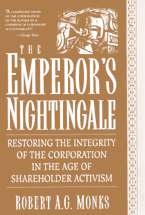"The Emperor's Nightingale: Restoring the Integrity of the Corporation in the Age of Shareholder Activism," by Robert A.G. Monks
The Emperor's Nightingale: Restoring the Integrity of the Corporation in the Age of Shareholder Activism by Robert A.G. Monks (283 pages, Addison-Wesley, 1998)
(originally published by Booz & Company) For the most recent part of his varied career, Robert A.G. Monks has been an activist investor, buying into underperforming companies that could be improved through shareholder involvement and wresting enough power to turn them around. Unfortunately, The Emperor's Nightingale is not about that experience (something Mr. Monks has covered in previous books on the role of institutional investors in corporate governance). Rather, this work is a mostly meandering attempt to attach a new theory to a decades-old practice and project a vision for the future.
For the most recent part of his varied career, Robert A.G. Monks has been an activist investor, buying into underperforming companies that could be improved through shareholder involvement and wresting enough power to turn them around. Unfortunately, The Emperor's Nightingale is not about that experience (something Mr. Monks has covered in previous books on the role of institutional investors in corporate governance). Rather, this work is a mostly meandering attempt to attach a new theory to a decades-old practice and project a vision for the future.
In the process, Mr. Monks finds inspiration in such diverse sources as Hans Christian Andersen, Adam Smith and Adolf A. Berle. Like the fabler, economist and New Dealer, Mr. Monks warns of the dangers of unlimited size and power. He names his book for a classic Hans Christian Andersen story about a ruler who cherished a mechanical golden bird until one day he realized that a less predictable living species, the nightingale, had a more impressive range and repertoire.
Building on Mr. Smith's observation that corporations are indifferent to the happiness or misery of those who work for them, Mr. Monks tells us that society has acquiesced in this behavior because society profits from it. He also reminds us, as Mr. Berle did, of the gap in the corporate structure between ownership and control.
Without citing much evidence, Mr. Monks spends the first four chapters laying out his thesis that the most popular methods of corporate accountability have failed during the past two centuries. He asserts that those who put their faith in the chief executive officer as philosopher-king just license these leaders to advance their own interests in compensation, even if it harms the general public and shareholders. He laments that independent directors are too hard to find. He proposes that well-structured boards can be insensitive to the needs of the public unless there are also active shareholders. He cautions that independent experts assigned "to review and bless the balancing of public and private interests" just appease current and prospective customers.
The solution to these concerns, he concludes, is to develop "a system in which corporations are accountable to a party that is independent, informed, motivated and empowered." Only long-term, institutional shareholders, he feels, can fulfill this mission.
One expects at this juncture specific examples, perhaps drawn from Mr. Monks' own work as a board member of a dozen publicly held companies; as the founder of Lens Inc. (an investment fund based in Washington, D.C.), and as the person who started Institutional Shareholder Services, a corporate governance company. Instead, the author serves up yet more theory, struggling to create a new, cumbersome lexicon to embellish a relatively simple concept.
Mercilessly, Mr. Monks plunges us into the world of complex adaptive systems, more familiar to students of physics, biology and economics. The gist of it is that corporations are not untamed, profit-seeking machines, but artificial life forms with a capacity to achieve the appropriate size and power. With the right dynamic — among shareholders, managers, governments, customers and society — they can become accountable to their owners. It is up to us to choose between short-term profit maximization and long-term economic value rooted in social good.
Who precisely are the shareholders who can make a big enough difference? Institutional investors — pension funds, mutual funds, insurance companies, banks, trust companies and foundations — are ideally suited for the role of what the author calls "the new owner." Since their beneficiaries are easily defined (for instance, people who will retire), it is easy to identify those to whom they are accountable.
Although Mr. Monks would have us believe that good corporate governance pays, he offers very few examples of institutional investors taking the lead. Only in a laundry list of credits does he tell us that he has been an activist investor at the American Express Company, the Westinghouse Electric Company, the Eastman Kodak Company and Sears, Roebuck & Company. He supplies no details about how he put his methods to work at any of these companies.
The only real case study deals with his efforts during the mid-1990's to correct a "governance gap" at Stone & Webster, an old-line construction company that was the main contractor for the Manhattan Project. Upon discovering that the company was keeping a significant portion of its pen- sion in liquid assets, Mr. Monks tells us he proposed himself and another qualified shareholder as candidates for the company's board of directors. Ultimately, new shareholders acquired enough equity that one of them was elected to the stagnating board of directors. As other spots on the board turned over, the company changed its financial strategies, its structure and even its location. In the process, it also boosted its share price.
Why have not more institutional investors been activists? The author's answer is by implication self-serving: It is expensive, they do not want to antagonize management and they do not have the expertise. Yet Mr. Monks is confident that pensioners can "usher in a new corporate world" during the next century. One wishes that he had supplied a blueprint based on his own track record for precisely how to do that. ![]()
Reprint No. 99310

